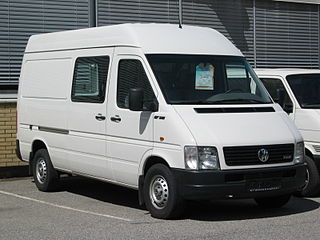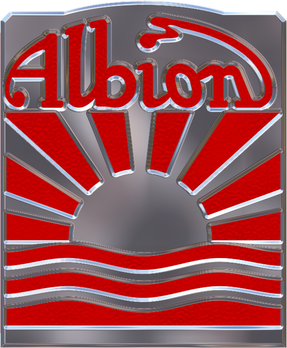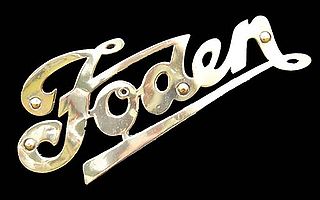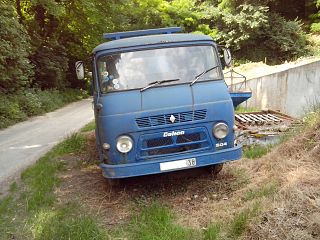
DAF Trucks is a Dutch truck manufacturing company and a division of Paccar. DAF originally stood for van Doorne's Aanhangwagen Fabriek. Its headquarters and main plant are in Eindhoven. Cabs and axle assemblies are produced at its Westerlo plant in Belgium. Some of the truck models sold with the DAF brand are designed and built by Leyland Trucks at its Leyland plant in the United Kingdom.

British Leyland was an automotive engineering and manufacturing conglomerate formed in the United Kingdom in 1968 as British Leyland Motor Corporation Ltd (BLMC), following the merger of Leyland Motors and British Motor Holdings. It was partly nationalised in 1975, when the UK government created a holding company called British Leyland, later renamed BL in 1978. It incorporated much of the British-owned motor vehicle industry, which in 1968 had a 40% share of the UK car market, with its history going back to 1895. Despite containing profitable marques such as Jaguar, Rover, and Land Rover, as well as the best-selling Mini, BLMC had a troubled history, leading to its eventual collapse in 1975 and subsequent part-nationalisation.

Leyland Motors Limited was an English vehicle manufacturer of lorries, buses and trolleybuses. The company diversified into car manufacturing with its acquisitions of Triumph and Rover in 1960 and 1967, respectively. It gave its name to the British Leyland Motor Corporation, formed when it merged with British Motor Holdings in 1968, to become British Leyland after being nationalised. British Leyland later changed its name to simply BL, then in 1986 to Rover Group.

The Volkswagen LT is the largest light commercial panel van produced by Volkswagen from 1975 to 2006, before being replaced by the Crafter. Two generations were produced.

The Autocar Company is an American specialist manufacturer of severe-duty, Class 7 and Class 8 vocational trucks, with its headquarters in Birmingham, Alabama. Started in 1897 in Pittsburgh, Pennsylvania, as a manufacturer of Brass Era automobiles, and trucks from 1899, Autocar is the oldest surviving motor vehicle brand in the Western Hemisphere.

Seddon Atkinson Vehicles Limited, was a manufacturer of large goods vehicles based in Oldham, Greater Manchester, England, was formed after the acquisition in 1970 of Atkinson Vehicles Limited of Preston by Seddon Diesel Vehicles Limited of Oldham. In 1974, the firm was acquired by International Harvester, which sold it in March 1984 to the Spanish group Enasa which made it a subsidiary of Pegaso. In 1990, it became part of Iveco which used the brand for various types of specialised vehicles in the United Kingdom. The range of models produced included EuroMover, Pacer and Strato, which are aimed at refuse collection, recycling and construction operators.

Albion Motors was a Scottish automobile and commercial vehicle manufacturer.
Scammell Lorries Limited was a British manufacturer of trucks, particularly specialist and military off-highway vehicles, between 1921 and 1988. From 1955 Scammell was part of Leyland Motors.

Foden Trucks was a British truck and bus manufacturing company, which had its origins in Elworth near Sandbach in 1856. Paccar acquired the company in 1980, and ceased to use the marque name in 2006.
Bedford Vehicles, usually shortened to just Bedford, was a brand of vehicle manufactured by Vauxhall Motors, then a subsidiary of multinational corporation General Motors. Established in April 1931, Bedford Vehicles was set up to build commercial vehicles. The company was a leading international lorry brand, with substantial export sales of light, medium, and heavy lorries throughout the world.

BMC Otomotiv Sanayi ve Ticaret A.Ş., doing business as BMC Otomotiv and BMC, is one of the largest automobile manufacturers in Turkey. Its products include commercial trucks, buses, military trucks and armoured vehicles. The company was founded in 1964 by Ergün Özakat in partnership of British Motor Corporation which held a 26% stake. It was purchased by Çukurova Holding in 1989, and seized by the Turkish government's TMSF in 2013. BMC has been taken over with a final bid of TL 751M, by a partnership of 51% Turkish side and 49% Qatari side.

Morris Commercial Cars Limited is a British manufacturer of commercial vehicles formed by William Morris, founder of Morris Motors Limited, to continue the business of E G Wrigley and Company which he purchased as of 1 January 1924.

The Maudslay Motor Company was a British vehicle maker based in Coventry. It was founded in 1901 and continued until 1948 when it was taken over by the Associated Equipment Company (AEC) and along with Crossley Motors the new group was renamed Associated Commercial Vehicles (ACV) Ltd.

MAN Truck & Bus SE is a subsidiary of Traton, and one of the leading international providers of commercial vehicles. Headquartered in Munich, Germany, MAN Truck & Bus produces vans in the range from 3.0 to 5.5 t gvw, trucks in the range from 7.49 to 44 t gvw, heavy goods vehicles up to 250 t road train gvw, bus-chassis, coaches, interurban coaches, and city buses. MAN Truck & Bus also produces diesel and natural-gas engines. The MAN acronym originally stood for Maschinenfabrik Augsburg-Nürnberg AG, formerly MAN AG.

BharatBenz is a brand of Daimler India Commercial Vehicles (DICV), itself a wholly owned subsidiary of the German manufacturer Daimler Truck AG. The brand is known for its trucks and buses. The headquarters of BharatBenz is at Oragadam, Chennai, India.

The Saviem J was a range of medium-duty trucks manufactured by the French manufacturers Saviem and Renault Véhicules Industriels between 1975 and 1980.

The DAF F218 and later F220 is the name of a modular cab used on a series of medium-duty trucks produced by the Dutch manufacturer DAF from early 1970 until the mid-1990s. The names reflect the cab width in centimetres, at 218 and 220 cm respectively. DAF's first tilting cab design, all in steel, it also benefitted from a new 8.25 L (503 cu in) diesel inline-six. After a thorough facelift with a new front clip in the style of the larger F241 series, the cab was renamed the F220 in 1976. The range was originally sold as the F1600 or F2000, with the new model F220 marketed as the F2300. Gradually, a number of other iterations appeared, with the range eventually stretching from the 1700 to the intercooled 2700 ATi.

The Saviem Super Galion is a truck under 6 tonnes gross vehicle weight (GVW) produced by the French manufacturer Saviem between 1965 and 1982. It was also marketed as the Renault Super Galion.

The Bedford S is a heavy lorry produced in Great Britain between 1950 and 1959. Launched at the Commercial Vehicle Show in 1950, it was the largest Bedford lorry available at the time. Originally available only with a 110 bhp (82 kW) petrol engine, a diesel was added in 1953. The lorry proved popular amongst haulers and general traders, for fire engines, and was used for the first liquid egg tanker in 1966.

The Morris WE/Austin S203/S403/S503 was a bonneted truck produced by the British Motor Corporation from 1955. After a revision in 1964, it was marketed as the Morris WF/Austin S303/S403/S503 and from 1968 as the BMC WF. In the export markets, the Austin model was usually called the Morris, WE/WF. After BMC merged with Leyland Motors to form the British Leyland Motor Corporation, it was produced as the Leyland WF from 1970 to 1981 and replaced by the Leyland Landmaster.


















